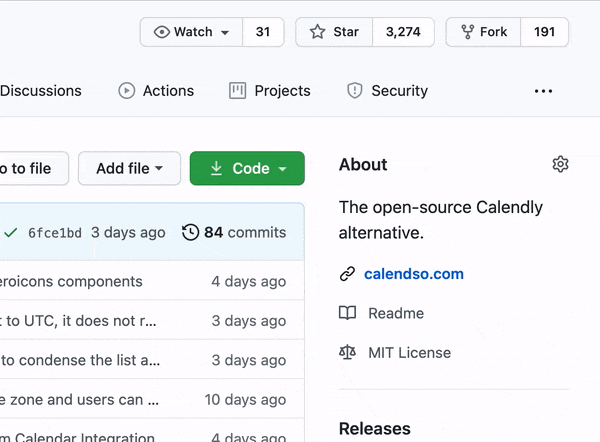Co-authored-by: kodiakhq[bot] <49736102+kodiakhq[bot]@users.noreply.github.com> |
||
|---|---|---|
| .github | ||
| .husky | ||
| .vscode | ||
| components | ||
| cypress | ||
| ee | ||
| lib | ||
| pages | ||
| prisma | ||
| public | ||
| scripts | ||
| server | ||
| styles | ||
| test/lib | ||
| .babelrc | ||
| .editorconfig | ||
| .env.example | ||
| .eslintignore | ||
| .eslintrc.json | ||
| .gitignore | ||
| .kodiak.toml | ||
| .npmrc | ||
| .nvmrc | ||
| .prettierignore | ||
| .prettierrc.js | ||
| .vercelignore | ||
| LICENSE | ||
| README.md | ||
| calendso.yaml | ||
| cypress.json | ||
| docker-compose.yml | ||
| environment.d.ts | ||
| next-env.d.ts | ||
| next-i18next.config.js | ||
| next.config.js | ||
| package.json | ||
| postcss.config.js | ||
| project.toml | ||
| tailwind.config.js | ||
| tsconfig.json | ||
| yarn.lock | ||
README.md
Cal.com (formerly Calendso)
The open-source Calendly alternative.
Learn more »
Slack
·
Website
·
Issues
About The Project

Scheduling infrastructure for absolutely everyone.
The open source Calendly alternative. You are in charge of your own data, workflow and appearance.
Calendly and other scheduling tools are awesome. It made our lives massively easier. We're using it for business meetings, seminars, yoga classes and even calls with our families. However, most tools are very limited in terms of control and customisations.
That's where Cal.com comes in. Self-hosted or hosted by us. White-label by design. API-driven and ready to be deployed on your own domain. Full control of your events and data.
Product of the Month: April
Support us on Product Hunt
Built With
Stay Up-to-Date
Cal officially launched as v.1.0 on 15th of September, however a lot of new features are coming. Watch releases of this repository to be notified for future updates:
Getting Started
To get a local copy up and running, please follow these simple steps.
Prerequisites
Here is what you need to be able to run Cal.
- Node.js
- PostgreSQL
- Yarn (recommended)
You will also need Google API credentials. You can get this from the Google API Console. More details on this can be found below under the Obtaining the Google API Credentials section.
Development Setup
Quick start with yarn dx
- Requires Docker to be installed
- Will start a local Postgres instance with a few test users - the credentials will be logged in the console
git clone git@github.com:calendso/calendso.git
cd calendso
yarn
yarn dx
Manual
-
Clone the repo
git clone https://github.com/calendso/calendso.git -
Install packages with yarn
yarn install -
Copy
.env.exampleto.env -
Configure environment variables in the .env file. Replace
<user>,<pass>,<db-host>,<db-port>with their applicable valuesDATABASE_URL='postgresql://<user>:<pass>@<db-host>:<db-port>' GOOGLE_API_CREDENTIALS='secret'If you don't know how to configure the DATABASE_URL, then follow the steps here
-
Create a free account with Heroku.
-
Create a new app.

-
In your new app, go to
Overviewand next toInstalled add-ons, clickConfigure Add-ons. We need this to set up our database.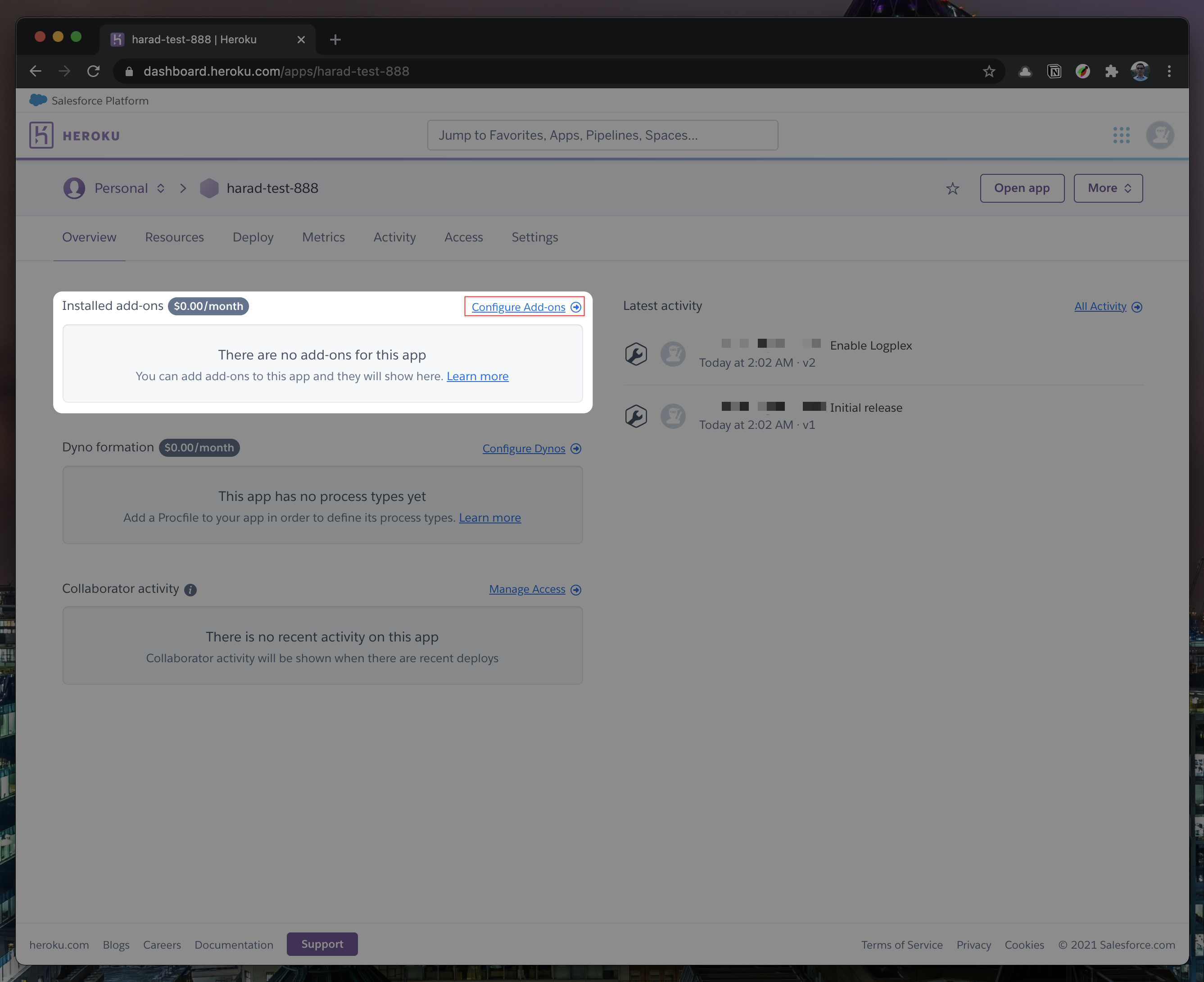
-
Once you clicked on
Configure Add-ons, click onFind more add-onsand search forpostgres. One of the options will beHeroku Postgres- click on that option.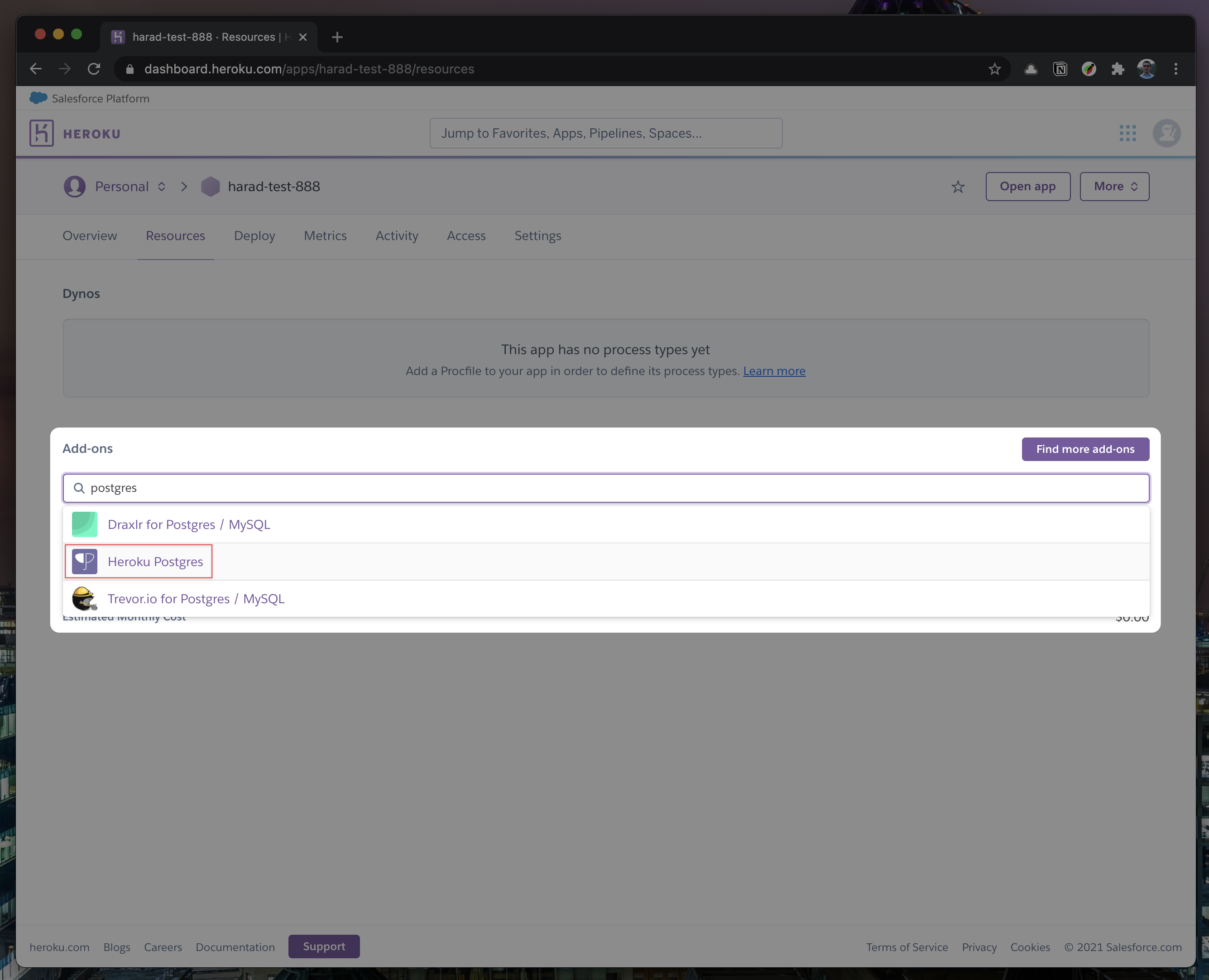
-
Once the pop-up appears, click
Submit Order Form- plan name should beHobby Dev - Free.
-
Once you completed the above steps, click on your newly created
Heroku Postgresand go to itsSettings.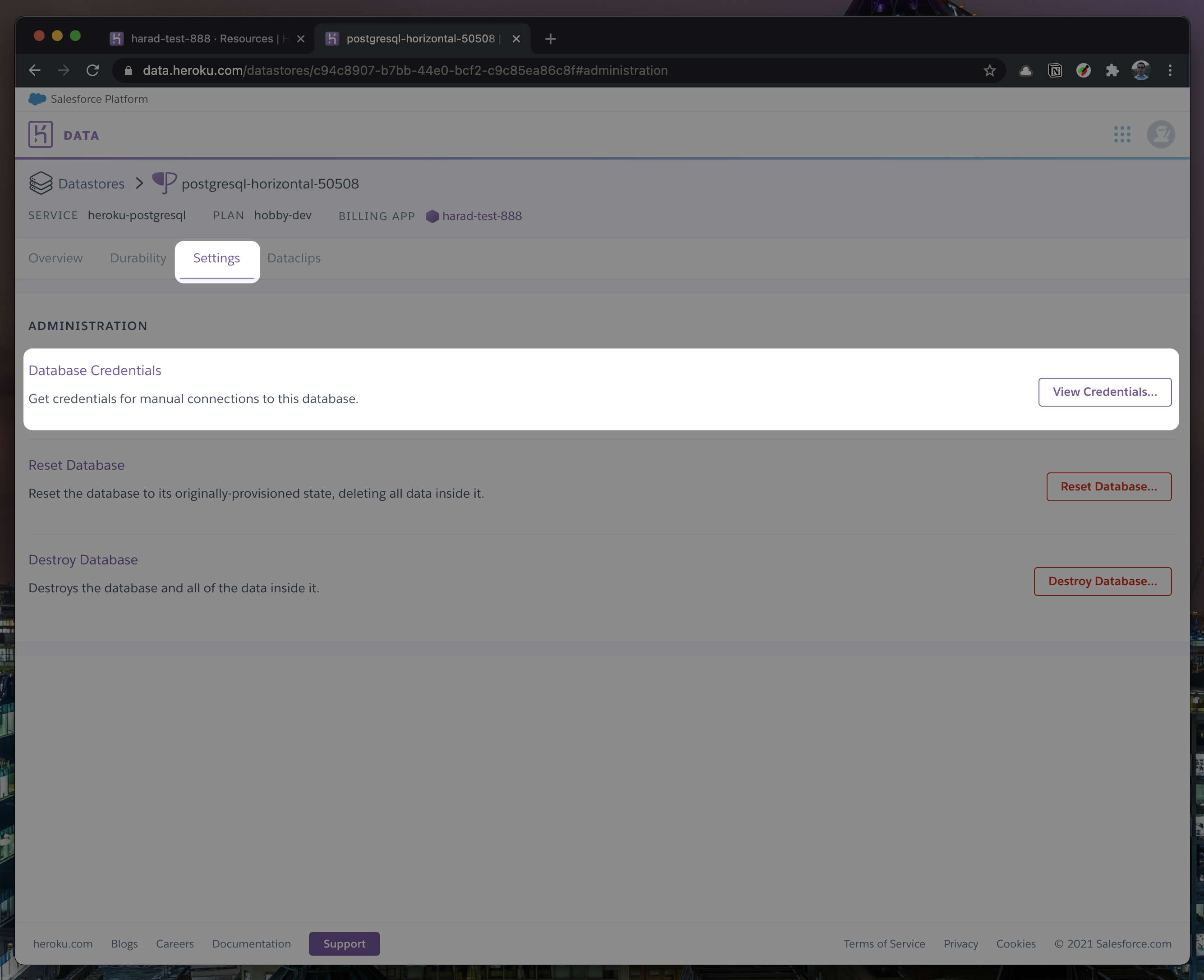
-
In
Settings, copy your URI to your Cal.com .env file and replace thepostgresql://<user>:<pass>@<db-host>:<db-port>with it.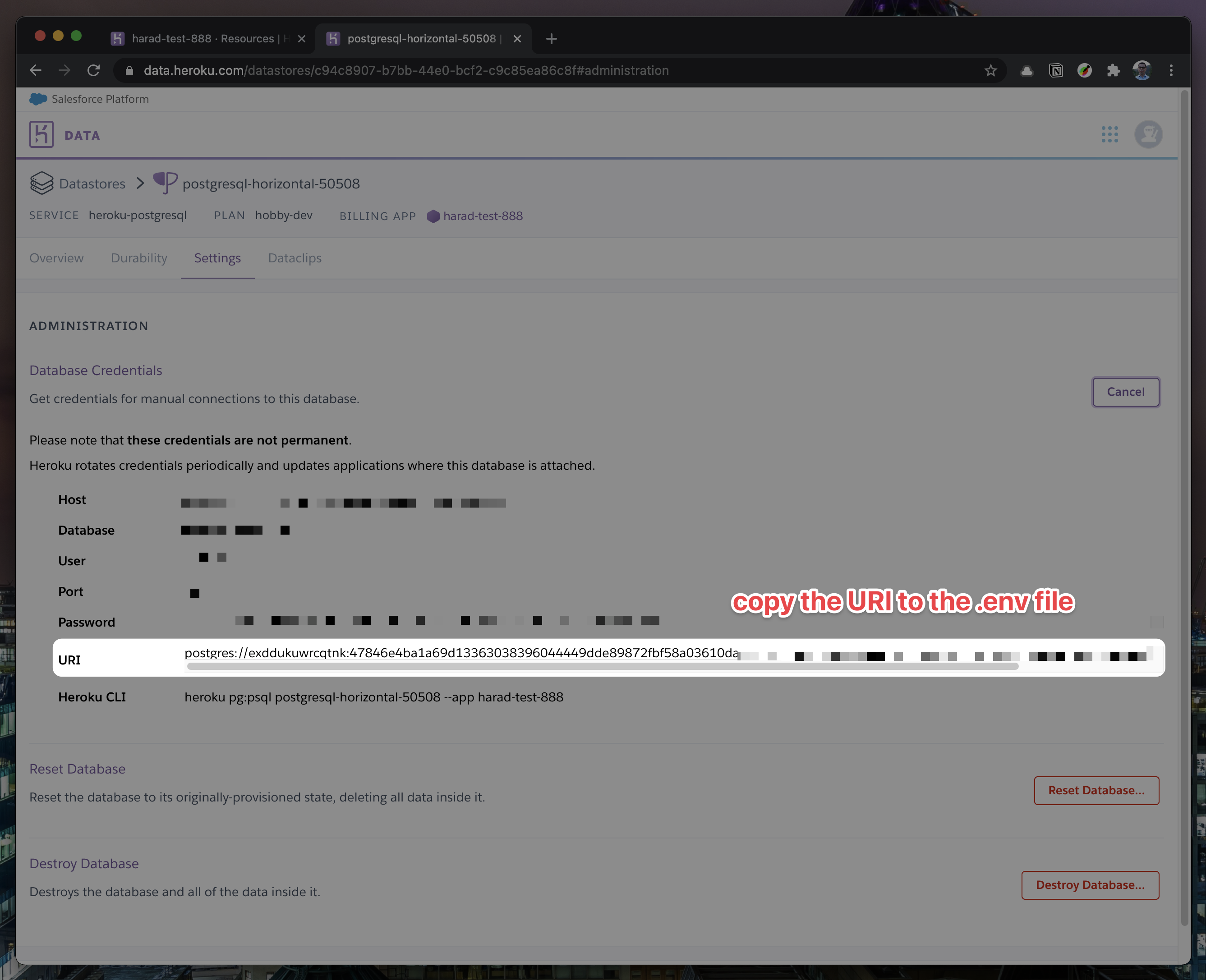

-
To view your DB, once you add new data in Prisma, you can use Heroku Data Explorer.
-
-
Set up the database using the Prisma schema (found in
prisma/schema.prisma)npx prisma db push -
Run (in development mode)
yarn dev -
Open Prisma Studio to look at or modify the database content:
npx prisma studio -
Click on the
Usermodel to add a new user record. -
Fill out the fields (remembering to encrypt your password with BCrypt) and click
Save 1 Recordto create your first user. -
Open a browser to http://localhost:3000 and login with your just created, first user.
-
Set a 32 character random string in your .env file for the CALENDSO_ENCRYPTION_KEY.
Upgrading from earlier versions
-
Pull the current version:
git pull -
Apply database migrations by running one of the following commands:
In a development environment, run:
npx prisma migrate dev(this can clear your development database in some cases)
In a production environment, run:
npx prisma migrate deploy -
Check the
.env.exampleand compare it to your current.envfile. In case there are any fields not present in your current.env, add them there.For the current version, especially check if the variable
BASE_URLis present and properly set in your environment, for example:BASE_URL='https://yourdomain.com' -
Start the server. In a development environment, just do:
yarn devFor a production build, run for example:
yarn build yarn start -
Enjoy the new version.
Deployment
Docker
The Docker configuration for Cal is an effort powered by people within the community. Cal.com, Inc. does not provide official support for Docker, but we will accept fixes and documentation. Use at your own risk.
The Docker configuration can be found in our docker repository.
Railway
You can deploy Cal on Railway using the button above. The team at Railway also have a detailed blog post on deploying Cal on their platform.
Roadmap
See the open issues for a list of proposed features (and known issues).
Contributing
Contributions are what make the open source community such an amazing place to be learn, inspire, and create. Any contributions you make are greatly appreciated.
- Fork the project
- Create your feature branch (
git checkout -b feature/AmazingFeature) - Make your changes
- Commit your changes (
git commit -m 'Add some AmazingFeature') - Push to the branch (
git push origin feature/AmazingFeature) - Open a pull request
Obtaining the Google API Credentials
- Open Google API Console. If you don't have a project in your Google Cloud subscription, you'll need to create one before proceeding further. Under Dashboard pane, select Enable APIS and Services.
- In the search box, type calendar and select the Google Calendar API search result.
- Enable the selected API.
- Next, go to the OAuth consent screen from the side pane. Select the app type (Internal or External) and enter the basic app details on the first page.
- In the second page on Scopes, select Add or Remove Scopes. Search for Calendar.event and select the scope with scope value
.../auth/calendar.events,.../auth/calendar.readonly,.../auth/calendarand select Update. - In the third page (Test Users), add the Google account(s) you'll using. Make sure the details are correct on the last page of the wizard and your consent screen will be configured.
- Now select Credentials from the side pane and then select Create Credentials. Select the OAuth Client ID option.
- Select Web Application as the Application Type.
- Under Authorized redirect URI's, select Add URI and then add the URI
<Cal.com URL>/api/integrations/googlecalendar/callbackreplacing Cal.com URL with the URI at which your application runs. - The key will be created and you will be redirected back to the Credentials page. Select the newly generated client ID under OAuth 2.0 Client IDs.
- Select Download JSON. Copy the contents of this file and paste the entire JSON string in the .env file as the value for GOOGLE_API_CREDENTIALS key.
Obtaining Microsoft Graph Client ID and Secret
- Open Azure App Registration and select New registration
- Name your application
- Set Who can use this application or access this API? to Accounts in any organizational directory (Any Azure AD directory - Multitenant)
- Set the Web redirect URI to
<Cal.com URL>/api/integrations/office365calendar/callbackreplacing Cal.com URL with the URI at which your application runs. - Use Application (client) ID as the MS_GRAPH_CLIENT_ID attribute value in .env
- Click Certificates & secrets create a new client secret and use the value as the MS_GRAPH_CLIENT_SECRET attriubte
Obtaining Zoom Client ID and Secret
- Open Zoom Marketplace and sign in with your Zoom account.
- On the upper right, click "Develop" => "Build App".
- On "OAuth", select "Create".
- Name your App.
- Choose "User-managed app" as the app type.
- De-select the option to publish the app on the Zoom App Marketplace.
- Click "Create".
- Now copy the Client ID and Client Secret to your .env file into the
ZOOM_CLIENT_IDandZOOM_CLIENT_SECRETfields. - Set the Redirect URL for OAuth
<Cal.com URL>/api/integrations/zoomvideo/callbackreplacing Cal.com URL with the URI at which your application runs. - Also add the redirect URL given above as a whitelist URL and enable "Subdomain check". Make sure, it says "saved" below the form.
- You don't need to provide basic information about your app. Instead click at "Scopes" and then at "+ Add Scopes". On the left, click the category "Meeting" and check the scope
meeting:write. - Click "Done".
- You're good to go. Now you can easily add your Zoom integration in the Cal.com settings.
License
Distributed under the AGPLv3 License. See LICENSE for more information.
Acknowledgements
Special thanks to these amazing projects which help power Cal.com:









